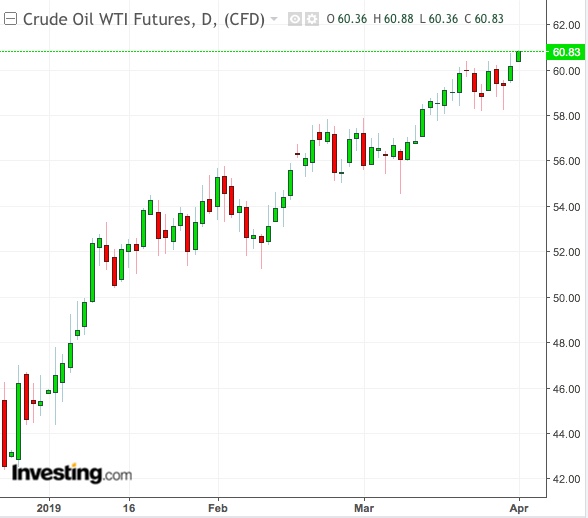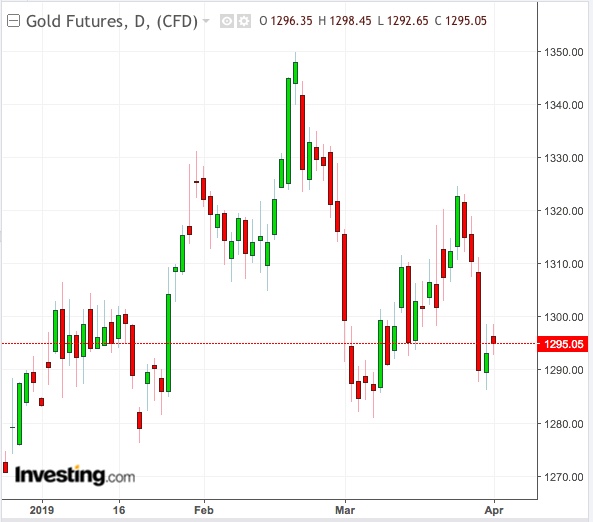There’s little dispute to Bloomberg’s remark that the first quarter will be a tough act for commodities to follow. What might be more telling is legendary British footballer Bill Shankly’s quip: “Aim for the sky and you'll reach the ceiling. Aim for the ceiling and you'll stay on the floor.”

That essentially sums up Saudi Arabia’s position. Aware that its quest for $80-and-above oil could come at the price of demand destruction and vehement opposition from U.S. President Donald Trump, Riyadh has dialed back its expectations to a more easily achievable $70 per barrel—despite its national budget requiring it to bill at least 20% more for its crude.
Onerous Expectations Likely On Demand
As the first three months of 2019 turned out to be the best quarter in three years for commodities, it appeared that not only oil, with its 32% gain, might have trouble replicating that phenomenal run. To keep up with the jump of 42% in gasoline, 26% in lean hogs and 22% in nickel, onerous expectations might have to be placed on demand, given the stuttering economic growth now in the U.S. and China, two of the world’s largest consumption centers.

Even gold bugs’ aim of making a run toward $1,400 an ounce in the second quarter might not pan out if the equity rally on Wall Street takes on a new life.
A monthly Reuters survey of economists and analysts last week forecast that Brent, the global oil benchmark for oil, would average $67.12 a barrel in 2019, about 1% higher than its previous poll, which predicted $66.44. That doesn’t look incredibly promising for the target the Saudis have on oil.
Positive Start To Q2, But For How Long?
In keeping with their Q1 momentum, oil and most commodities got off to a positive April start in Asian trading on Monday, aided by the prospect of more Saudi production cuts on oil and flatter-for-longer U.S. interest rates.
But few are betting for another runaway quarter in gains – not at least in crude, where Riyadh is expected to face Trump’s combative determination to keep pump prices of gasoline in the United States relatively low in the long run-up to next year’s election.
Scott Shelton, energy futures broker at ICAP in Durham, N.C. is one of the pessimists, despite data on Friday showing hedge funds and other money managers raised their bullish wagers on U.S. crude to the highest in more than five months.
Oil Seen Stuck In A Range
Said Shelton:
“I think it’s the general skepticism that we are going to be stuck in a range where $60 WTI is a sale and $65-$70 Brent is a sale, while $50 is the floor on WTI and perhaps $55 on Brent.”
“I am sticking with my guns that there are no real investors looking to be long on the oil market. While the strength has been impressive, it has been a function of spread strength rather than flat price strength.”
Shelton said carryover momentum from Q1 could lead to “a lot of anticipatory buying” at the front end of WTI and Brent, resulting in a surge in index length at the front end of the two markets over the next few weeks as investors see the opportunity to optimize on roll yields.
But he added that “after that is done, I do not see the longer-term buyer for crude”.
U.S. sanctions on Venezuelan oil would remain the wild card for the global supply situation, as much as Trump’s import waivers for buyers of Iranian oil, which are up for renewal in May.
New York-based Energy Intelligence said China was already defying Trump ahead of his decision on sanctions related to the two countries, by importing 35% more Iranian oil and an additional 532.000 barrels from Venezuela, both in February.
Trump Will Likely Prevent Saudis From Getting Their Way
Shelton said he had no illusions about what the president would choose if faced between cheaper oil and tighter Tehran sanctions “as upcoming U.S. elections are much more important than Iran’s nuclear capability”.
Bloomberg oil columnist Julian Lee said with Trump tweeting again last week that OPEC should raise production, the president was back to bullying the group’s de facto leader Riyadh, and was likely to get his way with the Kingdom.
Said Lee:
“Whatever happens, Saudi Arabia’s crude production will probably start to edge up again next month, as domestic needs increase with rising temperatures, even as the Kingdom continues to push a policy of restraint.”
“Having done more than they needed to in the first three months of the year, the Saudis have some flexibility to boost output now, if they feel the weight of political pressure from Washington is too heavy to ignore.”
